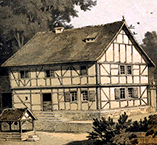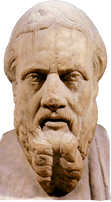|
|
|
|
 Luther's Home
Luther's Home
 |
|
  The Reformation: a HistoryBy Diarmaid MacCulloch  Introduction How are these terms defined:
Catholic What are the subjects of the third section of The Reformation?  Chapter 1" What were the two pillars of the power of the Medieval Church and how did they operate? What was the general condition of the late Medieval Church? Was it healthy or corrupt? What were its problems and its strengths? How are these terms defined: “blood libel”  Chapter 2: What does the chapter title mean by the terms “Hopes and Fears?” What was the situation on the borders of Western Europe in 1490? Describe the situation on the Iberian Peninsula in terms of the condition of the Church and also its relations with Jews and Muslims? What were the impact of paper and printing on Western Europe and the Church? Define Humanism and describe its impact on the Church? How did the monastic orders and the friars participate in the renewal and reform of the Church? Who was Erasmus and how was he significant on the eve of the Reformation? How are these terms defined: Ottoman Turks  Chapter 3: What were the ideas of St. Augustine of Hippo and what was his legacy to the western Church? Describe the background of Martin Luther and how he became involved with reform of the Church. How did his ideas differ from the Medieval Church? Describe the background of Ulrich Zwingli and how he became involved with reform of the Church. How did his ideas differ from Luther’s ideas? How were Luther’s ideas received by the common people of Germany from 1521-1524? How are these terms defined: Pelagius and Pelagians  Chapter 4: Describe the context and causes of the Great Peasants’ War in Germany. Some supporters of the Reformation followed churches supported by princes while others wanted individuals to be able to form separate churches within society. Describe who supported the first alternative and the second alternative, and why they gave their support. What were the causes of the fragmentation of Protestantism in the 1520s and early 1530s? Describe John Calvin’s career as discussed in ch. 4. How did the great kings Charles V of Germany, Francis I of France, and Sigismund of Poland each react to the Reformation? How did Henry VIII of England react? What was the incident at Munster and how did it affect the Anabaptist movement and other forms of religious radicalism? Define these terms: Thomas Muntzer  Chapter 5: Describe the revival of Roman Catholicism that occurred in Italy and Spain from the 1520s onward. What was the role of the Society of Jesus in the reform and revitalization of Catholicism? Describe the efforts to reconcile Catholics and Protestants during the early 1540s. Why did these efforts fail? What did the first session of the Council of Trent do to revitalize Catholicism and harden its differences with the Protestants? Describe how John Calvin established his Reformed Christianity in Geneva. What type of conflicts existed by clergy and the secular government in Geneva? Describe how Calvin’s views of the Eucharist differ from Luther and Zwingli’s? Describe the spread of the Reformed Christianity into Friesland, England, Poland, other parts of Eastern Europe, and France. Define these terms: Juan de Valdes  Chapter 6: What were the results of the war between the German Protestants and the Emperor Charles V? What were the policies and significance of the pontificate of Paul IV? What types of problems did the English queens Mary I and Elizabeth I face? Why did Mary I fail while Elizabeth I was relatively successful? Describe the impact of the Reformation on Scotland, the Austrian Habsburg lands, Spain, and France during the 1560s and 1570s. Discuss the achievements of the last session of the Council of Trent. Describe the origins of religious warfare in France and the Low Countries. Define these terms: Peace of Augsburg, 1555  Chapter 7: Describe the situation of religious division in Europe in circa 1569-72. How did the revived Catholic Church defend itself against its Protestant enemies and also against attacks by the Ottoman Turks? Describe the expansion of Protestantism in England, Scotland, Scandinavia and the Netherlands. What were the reasons for Protestant success in those countries? What was the impact of the St. Bartholomew’s Day Massacre in France and the rest of Europe? How did the course of the Reformation and religious division differ in the Kingdom of Poland-Lithuania from the rest of Protestant and Catholic Europe? What is the relationship between Protestantism and a belief in the End of Days in 1569-1572? Define these terms: Confessionalization  Chapter 8: What were the disagreements between Lutherans and between Lutherans and Reformed from 1546 to the 1570s? What was the nature of the Second Reformation in Germany? Describe the decline of religious diversity in Poland-Lithuania and what were the reasons that it took place? What was the nature of the Protestant State Church in the Netherlands? Did it have a monopoly over religion? Describe the issues and conflicts related to the struggle in the Dutch Reformed Church over the theology of Arminianism. Describe how and why Protestantism succeeded in Scotland and England. What problems did Protestants face from Catholic survivals? Describe how and why Protestantism failed in Ireland. Define these terms: Phillipipists  Chapter 9: How did the Catholic Church in Italy enforce the rules of the Council of Trent and solidify its control over Christian Italy? Describe the transformation of Spanish Catholicism during the reign of Philip II. Did it strengthen or weaken the Spanish Church? Define these terms: Roman Inquisition  Chapter 10: What was the condition of the Catholic Church in the Empire and the Habsburg lands during the reigns of the Emperors Ferdinand I and Maximilian II? Why were these rulers unable to suppress Protestantism? Describe how and why the Catholic Church was able to revive itself in Germany from the 1570s onward. What was the situation of Catholic, Lutheran, and Reformed Churches in the Hungarian and Transylvanian lands from 1570 to the 1650s? Describe the events and outcome of the French Civil Wars of Religion during the final decades of the sixteenth century. What was the nature of the Counter-Reformation in France and how was it related to Jansenism? Define these terms: Ferdinand I  Chapter 11: What was the nature of the conflict during the Thirty Years War as described in this chapter? Define these terms: Ferdinand II  Chapter 12: What did Richard Hooker and Lancelot Andrewes contribute to the development of the Church of England? How did the Church of England change from the reign of James I through the reign of Charles I? What was the nature of the Civil Wars in the British Isles and how did it effect Christianity in the islands? How did the Church of England reestablish itself during the reign of Charles II? What were the various ways that Christianity was brought to the British colonies in North America and how did it differ from the situation in the British Isles and Europe? Define these terms: The Law of Ecclesiastical Polity  Chapter 13: What was the role of beliefs about the end of the world during the Reformation? How did the people of the Reformation era view providence? Describe the Protestant war on idols. Which Protestants supported image breaking and which did not and why? The mass persecution of alleged witches was a feature of the Reformation era. How did belief in and the prosecution of witchcraft vary from region to region and among Lutherans, Reformed, and Roman Catholics? Define these terms: Joachim of Fiore  Chapter 14: How did Protestants change the funeral service and deal with magic compared to Catholics? What were the various ways that Protestants and Catholics taught adults and children the correct beliefs of their faiths? How were their methods different and how were they similar? What was meant by the concept of “discipline” in the sixteenth century and how and why did the Protestants and Catholic officials impose it on ordinary people? In what ways did Protestants promote a community of believers, including the calendar, the Eucharist, and revivalism? Was there a link between Protestant values and capitalism? Define these terms: Soul sleep  Chapter 15: What was the ancient legacy of beliefs about the nature of men and women that both Catholics and Protestants shared? Why did Protestants agree with Catholics on the perpetual virginity of Mary? How did the nuclear family function in the sixteenth century and did the Reformation change it? How did people of the Renaissance era understand the term “sodomy?” What was the situation of homosexual men during the era of the Reformation? Define these terms: Nuclear family  Chapter 16: What did the Reformation of Manners entail for the various European societies? How did syphilis and Erasmus effect the Reformation of Manners? How did the Reformation affect marriage rituals? How did marriage and the family change among Catholics as a result of the Reformation? What was the role of the Holy Family, celibacy, and female religious orders? How did Protestants change popular concepts of marriage and the family, particularly regarding clerical marriage and divorce? How did the role of woman in religion change during the course of the Reformation? Define this term: Girolomo Fracastoro  Chapter 17: What were some consequences of the Wars of Reformation? How did the Reformation contribute to the growth of religious toleration and other forms of toleration? How did humanism and natural philosophy interact with the Reformation in Protestant and Catholic lands? What was the situation of the Jews during the arrival of the Reformation and how did they contribute to growing doubt about the truth of religion? How does MacCulloch see developments in Protestantism and Catholicism from the eighteenth-century Enlightenment onward? Define these terms: Freemasonry Printer FriendlyFor a printer-friendly version of this webpage, If you don't have the Reader on your pc,  |
|
|
|
Historian, author, teacher, and higher education administrator, Dr. Ronald H. Fritze is Dean of the College of Arts and Sciences at Athens State University in Athens, Alabama. Ron has written for CornDancer since 2004. |
|
|
|
|
